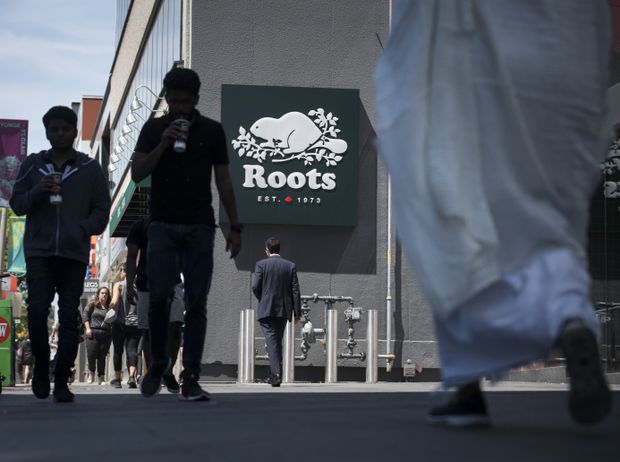
The Roots store at 1485 Yonge St. in midtown Toronto is photographed on June 12, 2019. Late on Friday afternoon, the company announced that chief executive Jim Gabel would be leaving the company immediately, citing a need for ‘renewed leadership.’ FRED LUM/THE GLOBE AND MAIL
Long before it was called “athleisure” and before Lululemon was selling $75 stretchy pants, Roots made it fashionable to pay a pretty penny for sweatpants. But behind the brand’s cozy image of nostalgic Canadiana, a corporate crisis has been brewing.
Since a peak in May of 2018, its stock has slid roughly 85 per cent. Sales have been below expectations, performance in its Asian markets has been choppy and an expansion into the United States has not gone well. Late on Friday afternoon, the company announced that chief executive Jim Gabel would be leaving the company immediately, citing a need for “renewed leadership” to improve operational efficiency and find growth.
The company hired Mr. Gabel as its president and CEO in 2016. At the time, Roots praised Mr. Gabel’s experience in shepherding global brands – through his former roles as president of Adidas in Canada and of Reebok in North America – as the Canadian retailer looked to expand its own customer base around the world.
Roots is now hunting for more than just a new CEO: Chief financial officer Jim Rudyk resigned in May and left in August. The interim CEO announced Friday, Meghan Roach, had been filling in as CFO. She came to that role from the retailer’s biggest shareholder, private equity firm Searchlight Capital Partners. Two chief merchandising officers departed last year as well: Priscilla Shum left Roots last February, and her replacement, Nancy Lepler, resigned last month for personal reasons, according to the company.
Searchlight took a majority stake in Roots in a deal in 2015 aimed at advancing the company’s growth ambitions and international push. Roots went public in 2017 in another deal that saw Searchlight and Roots founders Don Green and Michael Budman sell part of their stake to public investors at $12 a share.
While Roots sweatpants are still a coveted item especially among teens and tweens, and its products were likely found under many Canadian trees this holiday season, observers say it has work to do to remain healthy in the long term.
“They have to define what differentiates them from other lifestyle athletic wear. They’re stuck somewhere in the middle,” said Jean-Pierre Lacroix, president of retail consultancy Shikatani Lacroix Design. “Their relevancy is at play here. … If they continue business as usual, it’s a slowly declining model.”
Roots has had some trouble managing expectations – both its own and investors’.
In a prospectus filed just before its initial public offering in October, 2017, the company estimated that by 2019 its annual sales would increase to between $410-million and $450-million. By the following year, its guidance for 2019 sales had been scaled down, to an estimated $358-million to $375-million. Last month while reporting third-quarter earnings, executives conceded they would miss that target, too, and did not provide new guidance. Roots declined requests for an interview for this article.
Roots attributed the trouble to a few factors, including disappointing international sales. In addition to 115 Canadian stores, the company has seven corporate-owned stores in the U.S. and 150 stores operated via partnership in Taiwan, China and Hong Kong. The U.S. stores have not met expectations, the company said, and its Asian business was affected by “macroeconomic” factors, such as tensions between China and Taiwan and protests in Hong Kong.
In Canada, the retailer has also been transitioning to a new distribution centre for its products to unify the management of product shipments to e-commerce customers as well as to stores. But this has driven up costs, and in some cases, products did not make it to store shelves as efficiently, which affected sales. Sales in Roots leather goods and accessories were also soft in the three months ended Nov. 2.
Compounding the issue is that consumers are growing increasingly price sensitive because of competition from e-commerce giants Amazon.com Inc. and Walmart Inc. “Nobody wants to pay full price,” said George Minakakis, CEO of consultancy Inception Retail Group. “… If you want to stay in business, you have to drive sales, and those sales are coming from discounts, a lot more often.”
Roots needs to find new ways to draw customers into stores.
“The next step is, how do you get more products in the hands of consumers, and use that brand strength to augment that with new products,” said Matthew Lee, an analyst with Canaccord Genuity. He cited the example of the TUFF boot that Roots launched in partnership with Toronto Raptors star Fred VanVleet. The company – which began in the 1970s selling its popular “negative-heel” shoe – has said it plans to expand more into footwear.
“That’s a case where a strong Canadian brand teamed up with another strong Canadian brand, and put out a product that was high quality, something consumers wanted that looked good. The combination of those factors drove strong sales in a segment where they haven’t been a big player [more recently],” Mr. Lee said. “That is where Roots needs to go.”
SUSAN KRASHINSKY ROBERTSON
RETAILING REPORTER
The Globe and Mail, January 6, 2020
